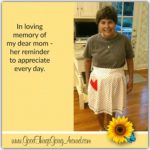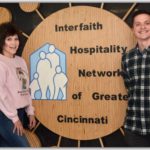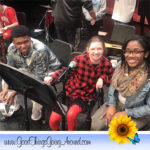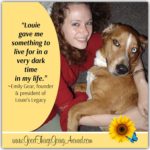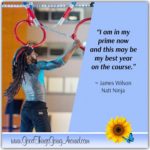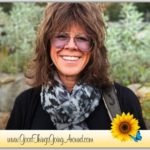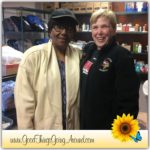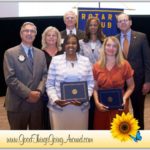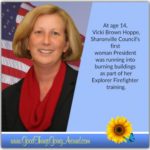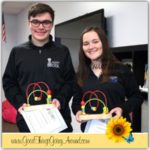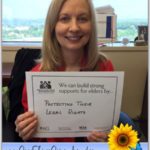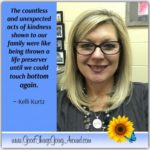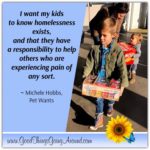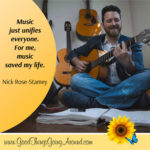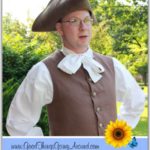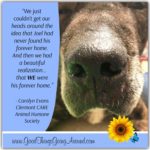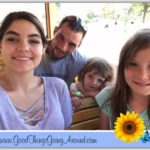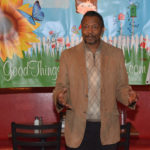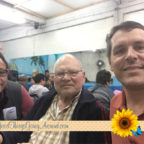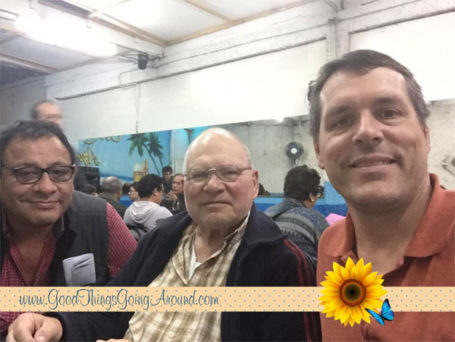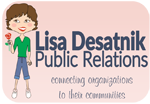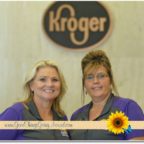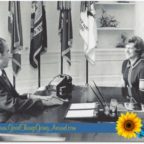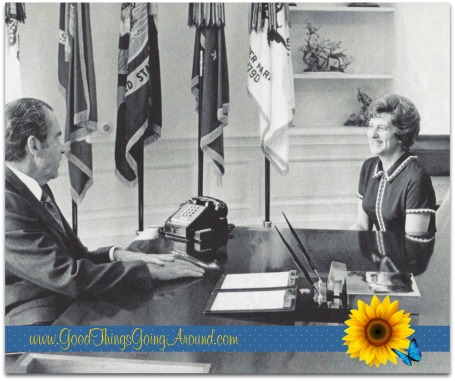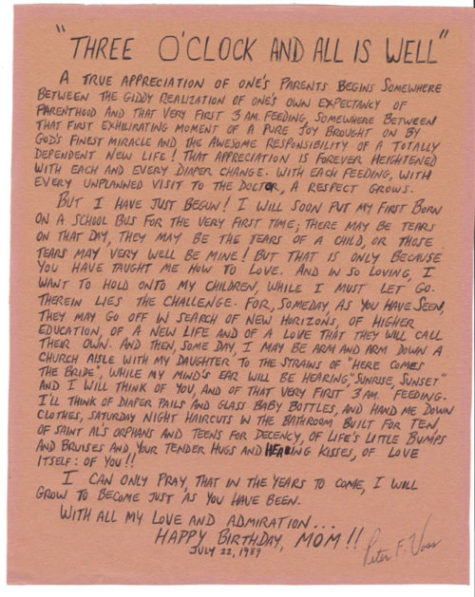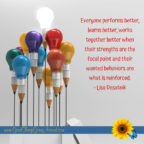Their Passion Is Helping Kids In Peru
Now I know where my intern, Walnut Hills High School student Isabella Noe gets her generosity and her drive. Her father, Bill Noe, is sharing his story below of a cause that is dear to his heart.
In Bill’s words…
“The Paul Lammermeier Foundation helps children-in-need reach their full potential by providing houses in Peru, centered on family and the Jesuit values of education and service to others.
This is their mission statement. The Foundation supports two boys’ homes and one girls’ home in Lima Peru. There are currently 17 boys and 4 girls in the houses. The children are either orphans or children who have difficult family situations that would make it otherwise difficult or impossible for them to get a good education.
I have known Paul Lammermeier since my freshman year in high school (1979). He was a teacher of mine and he ran the community service program at St. Xavier High School. He began taking mission trips down to Peru, and after several years, felt God was calling him to move there. He sold almost all of his possessions and moved to Peru in 1988 to teach at an inner-city Jesuit high school. He was drawn to the larger needs of the community and the children living on the streets. In 1993, he informally adopted two homeless boys, providing them with shelter, food, education, and moral guidance. He decided to formalize his work by establishing a home for boys. The foundation came into being in 1995 in support of Paul Lammermeier’s work with homeless children in Peru.
Paul inspires me in many ways. He lives the motto of “being a man for ot hers” through his life’s work of improving the lives of the children in Lima. His work permanently changes the lives of these children for the better, and like a ripple in the water, this in turn changes the lives of many others. Many of his former house residents are successful professionals and are involved in the foundation in Lima. In fact, one former resident, Juver, has started a house in the jungle country in Peru emulating Paul’s work.
hers” through his life’s work of improving the lives of the children in Lima. His work permanently changes the lives of these children for the better, and like a ripple in the water, this in turn changes the lives of many others. Many of his former house residents are successful professionals and are involved in the foundation in Lima. In fact, one former resident, Juver, has started a house in the jungle country in Peru emulating Paul’s work.
The Paul Lammermeier Foundation’s motto is “be a small part of little miracles”. I joined the board over 10 years ago as treasurer and have made several trips down to Peru to visit Paul and the children in the houses. I am always moved by the sense of family in these homes and the way the children call Paul “Pablo” and view him as a father. The PLF board realizes that by helping support Paul’s work we can be one of those small parts of little miracles. Paul has changed my life by showing me how acts of kindness and care for others can make positive, lasting changes.
- Bill Noe

Two Kroger Managers Begin Disability Support Group
Rachel Lawson, fresh meat and seafood planogram manager for Kroger, and Traci Stewart, deli category manager for Kroger, have more in common than simply their busy careers. They both happen to also be mothers to children who do things differently.
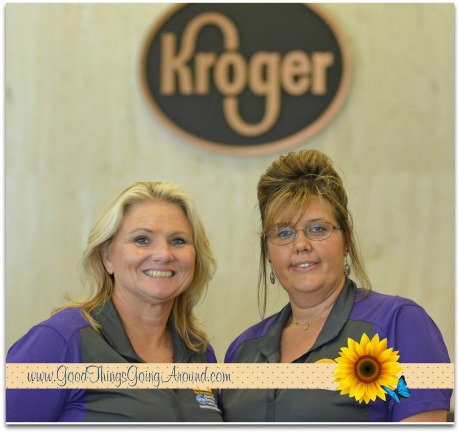 I met them both the other day when I visited them at the Kroger headquarters to take photos on behalf of my client, Cincinnati nonprofit LADD, Inc. (Living Arrangements for the Developmentally Disabled). Susan Brownknight, LADD’s executive director is chairing chairing the Advisory Committee of the Cincinnati USA Regional Chamber national pilot program to further disability inclusion in small businesses. Part of that program was Connect|Ability Week, a career shadowing experience for students with disabilities. On the day that I visited, college student Seth was spending his afternoon with the Kroger team.
I met them both the other day when I visited them at the Kroger headquarters to take photos on behalf of my client, Cincinnati nonprofit LADD, Inc. (Living Arrangements for the Developmentally Disabled). Susan Brownknight, LADD’s executive director is chairing chairing the Advisory Committee of the Cincinnati USA Regional Chamber national pilot program to further disability inclusion in small businesses. Part of that program was Connect|Ability Week, a career shadowing experience for students with disabilities. On the day that I visited, college student Seth was spending his afternoon with the Kroger team.
That Kroger was a participant in Connect|Ability Week was of no surprise. The company has been a strong leader and advocate when it comes to many issues…including integrating people with disabilities into our Greater Cincinnati community. For that, Kroger was recognized by LADD with its 2016 Legacy Award. “Kroger’s leadership has shifted the conversation relative to hiring people with disabilities. In many ways, this is not just about giving the Legacy Award, but also about moving the conversation forward on setting policies, protocols and procedures that facilitate inclusive workplace environments,” LADD Executive Director Susan Brownknight said of the company.
However, I learned last week that Kroger was doing even more than hiring a diverse workforce. Rachel and Traci have been spearheading a volunteer effort to support others in the company with life circumstances similar to their own.
It was over a year ago Traci approached her colleague about an idea she had, and Rachel didn’t think twice about jumping on board. That idea has grown into the Kroger Disabilities Resource Care Group that just officially launched in September, 2016. Its mission is to empower Kroger associates with disabilities and associates with dependents who have disabilities with an opportunity to network, address common issues and concerns, and receive support from those who share similar backgrounds, experiences or interests. The Resource Group is committed to providing resources and guidance when it comes to removing the greatest barriers for associates with disabilities, recognizes that all associates’ differences are valued, and wants to build an external awareness of Kroger as the employer of choice for people who experience disabilities.
On launch day in the downtown Cincinnati headquarters, Rachel told me they gave out gift bags and had 100 people register to be members. Then they went to the Kroger Grooms Road IT Department and had an additional 125 people register. Everyone who registered was sent a questionnaire about their greatest needs, and Rachel said they are just beginning to go through that data.
They have in place a plan to roll this out next to the Kroger divisions, beginning with Seattle, and ultimately will include all 2800 neighborhood stores.
Rachel shared some of her story with me. Her inspiration, she told me, comes from her experience raising her daughter with a learning disability who, in the fifth grade, was not reading or writing. Years of determination and support from professionals ultimately led Rachel to figuring out that her daughter saw things as if looking through a mirror. Finally diagnosed and prescribed appropriate medicine to slow her brain down so that she could begin to learn those basic skills, Rachel’s daughter is now a straight A student preparing to attend Morehead University and wants to be a chiropractor.
“Traci was so passionate about being there for me when I was struggling to help my daughter succeed. When she came to me with this idea, it was a no brainer. I knew this is what we needed to do to help others.
We thought it was going to be big but we didn’t anticipate it to be as big as it is turning out to be. Now we are finding there are a lot of associates like us.
I feel really good being a part of this. Now I feel like I am part of a whole community, that I am not the only one who has gone through this. That is the most important part.

Ruth Voss Was A Voice For Youth
Many years back and very early in my career, my mentor, Bill Mefford, told me about an organization for whom one of his friends was looking for a public relations contractor. Long story short, that woman was Ruth Voss and the organization that became my first long term PR client is Cincinnati nonprofit organization, Lighthouse Youth Services.
Ruth was the impetus for Lighthouse’s existence. (One of my close friends, Connie Dreyfuss, was a friend of Ruth’s and also one of the founding board members of Lighthouse.) I never had the fortune of meeting Ruth but from what I’ve learned about her, she was an incredible woman, mother, wife, and advocate.
Recently I’ve come to know one of Ruth’s sons, Peter, and through him I’m learning more about this woman whose impact is touching the lives of thousands of young people.
It was in 1971 when Ruth, then the Cincinnati Enquirer’s Teen-ager editor and mother of eight, received an urgent invitation to visit with President Nixon in the oval office of the White House. The President was looking for her ideas on getting youth involved in the country’s affairs. As can happen when one begins talking about their passion, that conversation quickly became pointed toward a Cincinnati half way house for girls that was just opening.
Ruth sat beside our country’s leader and told him the story of how she and a group of volunteers had tirelessly worked for four years to get that project off the ground, and how desperately short they were of operating funds. President Nixon looked her in the eyes and asked her how much she needed. “$30,000,” was her answer. “I’ll give you $50,000,” he told her.
That check led to Cincinnati’s New Life for Girls that ultimately became Lighthouse Youth Services, and that $50,000 was its first year’s budget. Peter told me how that allowed them to buy two homes – one in Madisonville and one on Ezzard Charles Drive. Ruth was a sorority sister of Marge Schott, whom also became a donor. One of those homes was names after the Reds’ former owner.
Peter tears up when he talks about his relationship with his mother. An only child, her parents were immigrants who came to the United States through Ellis Island and made a home in Cincinnati. She and her husband, Peter’s father, met on a blind date when they were attending University of Cincinnati. When they married, Ruth wanted a large family and was a loving role model to her children. Her strong heart for kids led to her work at the Enquirer, and her hosting events for and coaching young writers.
He shared with me a prose he wrote as a gift for his mother on her first birthday after his dad’s passing.
“ Mom cherished this gift with all her heart, and it remains on display in my home; always!,” Peter said, adding, “When my wife & I were dating, she was told by her ObGyn MD she would never have biological kids. We fooled science and were blessed with Katie & Bobby, two years apart. We NEVER take our children for granted; nor one another, as Gloria (his wife) nearly expired delivering Bobby!”
Peter told me if I had known his mother, I would have no doubt been her friend and I can absolutely see that. I wish I had had the opportunity to have met the woman who set my career path in motion but I am glad to know her son. Ruth’s impact lives on.

Power Is A Beautiful Thing
I joined the Toast of the Town Toastmasters Club earlier this summer and have been loving the experience. It is such a positive, supportive group that I hate to miss our Tuesday meetings. This week I gave my first speech. I have so appreciated the positive support I received from my friends on Facebook too. I thought I’d share my speech here. I deleted some personal information but the rest of it is pretty much what I said. (Well, not exactly, as I memorized it and adlibed a bit.)
Power is a Beautiful Thing
Have you ever stopped to think about the power that you have to affect lives? To empower, strengthen and ignite in people – in ourselves – a fire to want to do more, be more, achieve more.
To fill chasms in communication wells, break down stereotypes. We all have it you know.
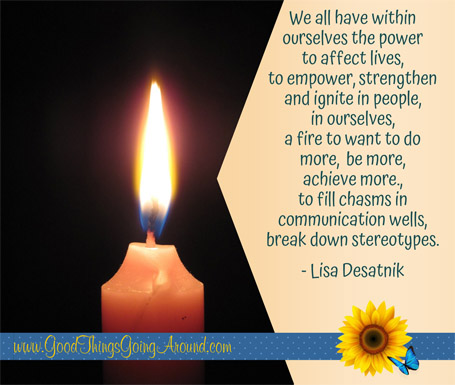 It is that power that drives many of my ambitions, my relationships and career choices.
It is that power that drives many of my ambitions, my relationships and career choices.
Let me tell you a story…
One day many years ago, I was working in my garden when two young girls, about 7, were suddenly standing on the other side of my fence. I had never seen or met them before. They were inquisitive and persistent. And, in the moment, as I stood holding a carton of pansies, I decided I could do with two less. From that one simple act, our lives became intertwined. Minutes later they reappeared around the fence and spent the remainder of the afternoon weeding, playing, laughing, talking. They came back often after that day, for the next year (until they moved away). Both from homes with personal challenges (to protect the girls, I am leaving out additional information), one became withdrawn when questions were asked and the other had a tendency to not always telling the truth.
At any other time these girls who were prone for trouble, but they always want to help me. And I always found projects for them to do. They watered my plants, sanded my backdoor, weeded my garden, helped me clean bird cages, all the while we talked and shared.
I think what they really wanted was my presence and a positive place where they were encouraged to grow. And they grew so much in the moments and days that we shared.
Those girls were not the reason why my quest for information led me to my first teacher and mentor in animal behavior, Dr. Susan Friedman, who pioneered the use of Applied Behavior Analysis (ABA) to captive and companion animals worldwide, or the reason I began writing about behavior but they were my first humans whose lives were strengthened as a result of my knowledge in Applied Behavior Analysis.
I mapped out a plan for how I would help them grow. I will never forget the day I came home to find a spilled can of pop on my back wooden porch. I was aggravated knowing it most likely was the little girl who had a talent for fiction. Then I remembered that she probably was there because it was a safe place to be after school. I didn’t say a word about it when she came over but the day that she told me what she had done was huge. I was so proud of her.
Yes, ABA has served me well. It has seen me go from sharing a home with an incessant screamer to an incessant talker. (That’d be my African Grey parrot, Barnaby) It has seen me strengthen my relationship with my pets, and led me down a path that has involved hundreds of hours of studying and practicing, ultimately earning the status of Certified Professional Dog Trainer – Knowledge Assessed and Certified Parrot Behavior Consultant.
And, ABA has helped me in my public relations work as well. Everyone performs better, learns better, works together better when their strengths are the focal point and their wanted behaviors are what is reinforced. It is a perspective that all managers, co-workers, and sales people can benefit from when it comes to motivating others to listen and take action.
I have always been one that has been driven to affect change. ABA is helping me to do that better but my drive to be a change agent has always been a part of me.
For more than 25 years, I have been using my communication skills to support the cause of organizations making profound impact on individuals and communities. I create messaging and strategies for raising awareness, building relationships that support individuals who are in constant pursuit of a world void of complacency and injustice. I’ve earned local and regional awards for projects and campaigns but the real reinforcement for me is in the change I am part of creating.
In 2014, I was hired for my largest project ever. I was part of a team whose shared purpose is inspiring others to look beyond differences to appreciate each other’s unique gifts that collectively strengthen us all. When I was hired by the Cincinnati ReelAbilities Film Festival much of Greater Cincinnati had never heard of it; and few people who I reached out to had any idea of the scope of the event or its value to our community – including me, admittedly.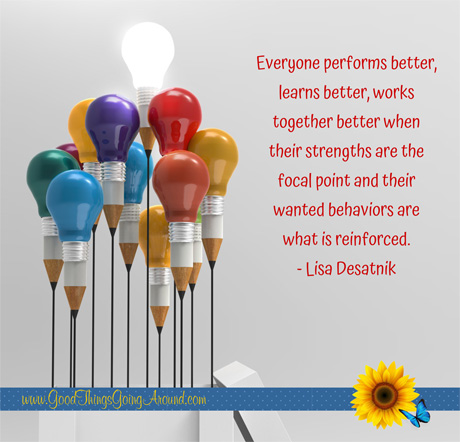
People experiencing a disability or cognitive, genetic, physical and behavioral difference are often misunderstood. They are portrayed in photos and sometimes news stories as ‘less than’ normal or super human just by virtue of their own being. They are often not included, or at least not to the extent that they are people first with interests, hopes, dreams, talents, and even bad days, just like everybody else. Yet ‘they’ are about 20% of our population. And ‘they’ are the only minority population in which all people will be counted among them at some point in their lives.
The overarching goal of LADD and ReelAbilities in hiring me was for me to be a catalyst for change – to bring the community together in support of not only an event but a cause so powerful as to have impact on each and every one of us in a direct or indirect way. I wanted to get people in this region talking to each other and realizing that inclusion and togetherness is not about ‘other people’, it is about themselves and each other. I wanted to get people excited about ReelAbilities as a world class film festival, and come out to support and learn from it. The challenge was to do all of this with a very limited budget including for my own time.
It exceeded beyond our wildest dreams. Events sold out. It was the talk of the region. It became a selling point for Greater Cincinnati. And its impact is continuing through inclusion in the workplace and in the community.
Pause
So, it was a Saturday night and I was rushing, preparing to go out….years after that beautiful day when I gave up two pansies in my garden. The girls’ families had long moved away, and although they were no longer present in my life, they will always have a place in my heart.
There was a knock on my back door. I opened it.
And, standing before me was a blossoming teenage girl standing before me. She remembered me. She remembered my impact.
Power is a beautiful thing.

Penguins Are His Passion
When Ric Urban walks into the area of Newport Aquarium where the African Penguins are housed, they all waddle over to him…especially one little girl, Paula. It is yet one more reason why this man who has been doing his work (Newport Aquarium is his fifth employer) for 35 years has no plans for retiring. He loves what he does. It is his passion and his purpose.
“With the birds at the Aquarium, I have been able to promote penguin conservation to a whole new level. When people see and meet a penguin, they are making a connection that will hopefully empower them to do something,” he said.
 As the Aquarium’s Chief Conservation Officer, Ric’s job is about promoting the mission of conversation in our community…and around the globe. He wants visitors of Northern Kentucky’s destination favorite to be enthralled while they are there, and leave with information to become interested and engaged in saving wildlife and the ecosystem beginning in their back yards.
As the Aquarium’s Chief Conservation Officer, Ric’s job is about promoting the mission of conversation in our community…and around the globe. He wants visitors of Northern Kentucky’s destination favorite to be enthralled while they are there, and leave with information to become interested and engaged in saving wildlife and the ecosystem beginning in their back yards.
However his job entails so much more. On any given day, he could be testing water, speaking to groups, teaching classes, creating programs, or traveling the globe. He has participated in many research projects through his career. This past spring he was appointed by the Association of Zoos and Aquariums (AZA) to be the program coordinator for the AZA SAFE African Penguin Identification Project. The goal of the Project has been to tag at least 10% of the world’s declining population of African Penguins over the next 3 years. That’s around 5,000 birds to be tagged and identified in South African and Namibia. It is an especially important program as African Penguins were placed on the endangered species list in 2010. The Newport Aquarium is one of 50 AZA-accredited zoos and aquariums that house these birds, and Ric did the original hand feeding of all eight that are on display in Northern Kentucky. Paula is often their ambassador, traveling with Ric on appearances to local events. I actually met Paula and Ric for the first time at a Muscular Dystrophy fundraiser.
When I asked Ric about his most interesting journey, he brought up the 2012 research project in Peru to learn about the Humoldt Penguin. They were working to prevent the decline in population of these birds, just as what has happened with the African Penguin. Guano, the fecal matter produced by sea birds, is a very effective and natural fertilizer, and of great value for the harvesters. The problem is that, being a natural pesticide, also makes guano an excellent place for Humoldt Penguins to lay eggs, and when the guano is harvested it has the potential for great harm to the Humoldt Penguin population. Ric was an observer. He was in South America to make sure the nests were undisturbed during harvesting. The whole experience was one he will never forget.
He shared this story.
“It was exciting to see wild Humoldt Penguins for the first time and go out with Peruvian biologists to watch what they are doing to save and protect the species, and preserve the ecosystems. Peru is one of the largest reserves for that penguin.
We were definitely roughing it. There was only power for three hours in the evening and no refrigeration. For toilets we had to use bail water from the ocean. We had male and female sides of the bathrooms, and would do bucket brigades every few days to fill the needed supply. We had to walk to the headquarters, about two miles away and across a coastal desert, to get a few minutes of shower time.
One night after our day was through, a young biologist invited me to explore. We wandered down into this area where the coastline had fallen onto the beach and created a long cave. The biologist had seen birds go there and then disappeared, and decided to follow them one day. That night he told me to crawl under a rock, and then we went on this incline that must have been 20 to 30 feet. You could feel the bottom of the cave below your belly and the space was so small that you couldn’t raise your neck. Then we got to the top and there must have been dozens of birds sitting on nests.
It was incredible. No where have I ever read about penguins nesting in the darkness of caves. It took everything I had ever learned and added a whole new level.”
With stories like that, it is no wonder why Ric has no immediate plans for retirement.

